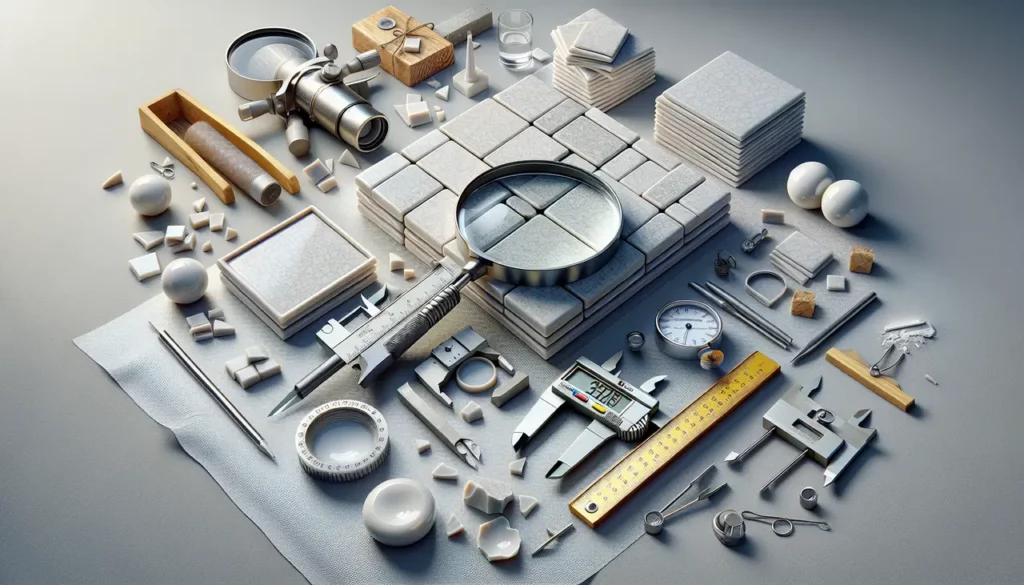Introduction to Porcelain Tile
Porcelain tile is a champion in durability and style, making it a top pick for floors and walls in homes and commercial spaces. Unlike its cousin, ceramic tile, porcelain is forged from very fine clay fired at extreme temperatures. This process makes it denser, less porous, and more resistant to moisture and stains. It’s known for holding up like a champ against wear and tear. Whether you’re daydreaming about your kitchen backsplash or planning a bathroom floor, knowing about porcelain tile will guide your choices. It comes in a variety of designs, colors, and sizes, offering flexibility for indoor and outdoor applications. Remember, not all porcelain tiles are created equal. The quality varies depending on the manufacturing process and the materials used. Keep this in mind as we dive deeper into how experts measure the quality of porcelain tile in the next sections.

Understanding Porcelain Tile Grades
Porcelain tiles are graded using a system that helps identify their quality, durability, and best use case. The Porcelain Enamel Institute (PEI) rating is what you want to look out for. This rating ranges from PEI 1 to PEI 5, showing the tile’s resistance to wear and its ability to handle foot traffic. Here’s a simple breakdown: PEI 1 tiles are only for wall use since they chip easily. Avoid putting them on floors. PEI 2 is good for light traffic areas like bathrooms. PEI 3 works well in residential spaces where there isn’t heavy foot traffic. PEI 4 is your go-to for higher traffic areas at home and some commercial spaces. PEI 5 can handle just about anything—perfect for busy public spaces. When shopping for porcelain tiles, always check their PEI rating to ensure you get the right tile for your needs. Choosing the correct grade saves you time and money in the long run, making sure your tiles remain beautiful and functional for years.
The Water Absorption Rate Test
The Water Absorption Rate Test is a big deal when it comes to measuring porcelain tile quality. Here’s why: the less water a tile can absorb, the better it is for places that get wet, like bathrooms or kitchens. Think of it like this—porcelain tiles are like sponges. A good quality sponge doesn’t soak up a lot of water quickly, right? The same goes for tiles. This test sorts tiles into different groups based on how much water they suck up. If a tile can absorb less than 0.5% of its weight in water, it’s considered top-notch, high-quality porcelain. This means it’s super dense and great for both indoor and outdoor use. So, when you’re picking out tiles, asking about the water absorption rate isn’t being picky; it’s being smart. You’re making sure you get the best bang for your buck.
PEI Rating: Measuring Wear Resistance
PEI rating is the secret sauce when picking porcelain tiles. It’s all about how well a tile stands up to foot traffic without wearing out. Think of it as a toughness scale. Rated 1 to 5, a tile with a PEI 1 is best for walls where shoes don’t tread. Move up the scale, and PEI 3 is cool for homes with normal foot action. At the top, PEI 5 handles the hustle and bustle of commercial spaces like malls. So, before laying down cash for tiles, ask, “What’s the PEI?” Tiles not up to the footwork in your space won’t last, leading to more spend down the road. Choose wisely, and your tiles will look sharp for years.
Coefficient of Friction: Safety Aspect
Tiles can be sleek, but that shouldn’t mean they’re a slip hazard. The Coefficient of Friction (COF) tells you exactly how slip-resistant a tile is. A higher COF means a tile offers more grip, making it safer underfoot. For spaces like bathrooms or outdoors, you want tiles with a high COF. It’s not just about looking good, it’s about staying on your feet. Keep an eye on those numbers to make sure your tiles are as safe as they are stylish.
Breaking Strength and Durability Test
When you’re picking out porcelain tiles, one big thing to look for is their strength and how long they’re going to last. The breaking strength and durability test tells you exactly that. Think of it like this: The breaking strength measures how much weight or pressure the tile can handle before it cracks or breaks. It’s usually shown in pounds. A good rule of thumb is to choose tiles with a breaking strength of at least 250 pounds for home use. For places with more foot traffic, like commercial areas, you’d want something even stronger. Now, durability. This test shows how well the tile stands up to wear and tear over time. It looks at things like how the tile handles heavy loads, if it’s likely to scratch, and whether it fades in sunlight. Tiles are rated from Class 1 to Class 5, with Class 5 being the toughest of them all. So, for areas in your home that see a lot of action, like the kitchen or hallway, aim for tiles rated Class 4 or 5. In short, checking the breaking strength and durability rating helps you pick tiles that not only look good but will also last longer and can take whatever life throws at them.
The Mohs Scale: Scratch Resistance
When it comes to flooring, especially with porcelain tiles, one key measure of quality is how well the tile can resist being scratched. This is where the Mohs Scale comes into play. Think of the Mohs Scale as a ruler for measuring how tough your tile is against scratches. It ranks materials from 1 to 10, with 1 being the softest, like talc, and 10 the hardest, like a diamond. Most porcelain tiles land somewhere between 6 and 8 on the Mohs Scale. This means they are pretty tough cookies, able to handle a fair bit of wear and tear without showing it. If you’ve got pets, kids, or just a busy household, knowing where your tiles stand on the Mohs Scale can help you choose a floor that keeps looking good, year after year. Just remember, the higher the number, the less you’ll have to worry about scratches from shoes, chairs, or whatever else life throws at it.
Variation in Size and Shape
Tiles that don’t match up can throw off your whole project. That’s why it’s key to pick tiles that are uniform. The deal is, porcelain tiles are judged heavily on how similar they are in size and shape. If you’re looking at high-quality ones, you’ll find they’re pretty much identical. But lower quality tiles? Those can be all over the place – different sizes, odd shapes, you name it. It’s not just about looks; uneven tiles make installation a headache and can affect the final appearance. So, when you’re choosing tiles, take a close look. High-quality tiles will keep your floors and walls looking sharp and make sure everything fits together just right.
Aesthetics and Visual Inspection
When it comes to porcelain tiles, looks matter a lot. The first thing to check is the tile’s design and finish. You want tiles that look good and fit the style you’re aiming for. But, it’s not just about the initial wow factor. You’ve got to dive deeper and check for consistency in color and pattern among different tiles. Tiles that don’t match up can make a finished space look sloppy. Next, focus on the surface. The glaze should be smooth without any pits or bumps, and there shouldn’t be any cracks or chips. Think about it, if the tile looks banged up right off the bat, imagine how it’ll hold up underfoot day in, day out. Also, take a step back and look at the tile from different angles and in different light. Some imperfections only show up under the harsh light of day. Remember, these tiles are going to be part of your space for a long time. Taking the time to give them a good once-over ensures you won’t face any surprises down the line.
Summary: Selecting the Right Porcelain Tile
Selecting the right porcelain tile might seem daunting, but it’s all about knowing what to look for. Focus on the tile’s grade, size, and finish. Grades range from 1 to 5, with grade 5 being the most durable. This makes it ideal for high-traffic areas. Size matters because larger tiles can make a small room appear bigger, but they require a flat surface to avoid cracking. The finish – glossy, matte, or textured – affects the tile’s look and slip resistance. Glossy tiles might look stunning but think twice for floors, especially in bathrooms, as they can be slippery. Matte or textured tiles offer better grip. Remember, the right tile combines functionality with your personal style.

